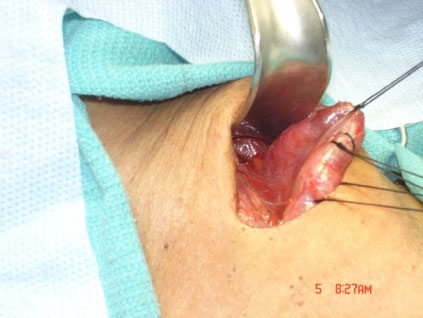
If you look carefully at the picture above you can see a normal parathyroid gland. The left thyroid lobe is being elevated out of the wound. Just below the silver retractor a small, faintly tan, structure can be appreciated just deep to the upper aspect of the thyroid. This is a normal parathyroid gland. In this case it is the left superior parathyroid gland.
The parathyroid glands are located in the neck behind the thyroid gland. They are separate glands from the thyroid. Generally, there are four glands. Two on each side, in the superior and inferior position. Normally they are about the size of an apple seeds.
The parathyroid glands make a hormone called … parathyroid hormone( PTH). This hormone regulates the calcium level in the blood. About 98% of calcium is in the bone, about 2% is in the blood stream. In the bone, calcium helps with structural support. In the blood, it mediates normal nerve and muscle function. PTH causes a net movement of calcium from the bones into the blood. As the calcium level in the blood increases the calcium particles stick to the parathyroid glands (at calcium sensing receptor sites) and this turns the glands off. The PTH level drops. The calcium particles then get resorbed into the bone. The calcium level in the blood drops, the calcium particles fall away from the parathyroid glands and they start working again. The PTH level goes up, leading to an increase in the blood calcium level. Through this process, the calcium level in the blood is kept fairly constant.
Parathyroid glands can be important from a surgical standpoint if they become over active. When this happens too much PTH is produced and this leads to a net movement of calcium from the bones into the blood stream. The calcium level in the blood becomes elevated. Over time this can result in a significant loss of calcium in the bones(osteoporosis) and other health issues such as kidney stones. A variety of non-specific symptoms may develop including severe fatigue, bone aching, muscle weakness, poor mental processing(sometimes so severe it may be confused with Alzheimer’s disease), abdominal pain, ulcers and high blood pressure. Chronically increased PTH production (hyperparathyroidism) has been associated with an increased risk of kidney failure and increased risk of death from heart disease. There are 3 types of hyperparathyroidism(HPT)
